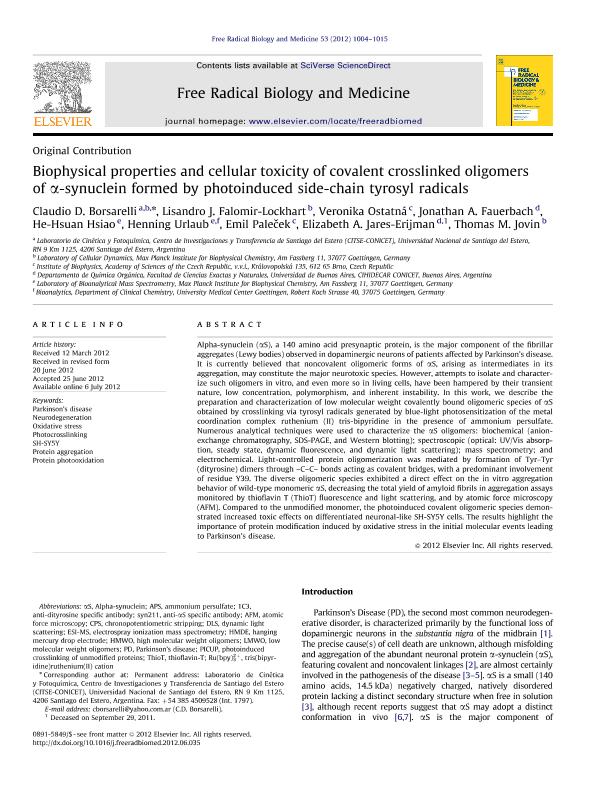Mostrar el registro sencillo del ítem
dc.contributor.author
Borsarelli, Claudio Darío

dc.contributor.author
Falomir Lockhart, Lisandro Jorge

dc.contributor.author
Ostatná, Veronika
dc.contributor.author
Fauerbach, Jonathan Arturo

dc.contributor.author
Hsiao, He Hsuan
dc.contributor.author
Urlaub, Henning
dc.contributor.author
Palecek, Emil
dc.contributor.author
Jares Erijman, Elizabeth A.
dc.contributor.author
Jovin, Thomas M.
dc.date.available
2023-05-12T14:23:59Z
dc.date.issued
2012-07
dc.identifier.citation
Borsarelli, Claudio Darío; Falomir Lockhart, Lisandro Jorge; Ostatná, Veronika; Fauerbach, Jonathan Arturo; Hsiao, He Hsuan; et al.; Biophysical properties and cellular toxicity of covalent crosslinked oligomers of α-synuclein formed by photoinduced side-chain tyrosyl radicals; Elsevier Science Inc.; Free Radical Biology and Medicine; 53; 4; 7-2012; 1004-1015
dc.identifier.issn
0891-5849
dc.identifier.uri
http://hdl.handle.net/11336/197306
dc.description.abstract
Alpha-synuclein (αS), a 140 amino acid presynaptic protein, is the major component of the fibrillar aggregates (Lewy bodies) observed in dopaminergic neurons of patients affected by Parkinson?s disease. It is currently believed that noncovalent oligomeric forms of αS, arising as intermediates in its aggregation, may constitute the major neurotoxic species. However, attempts to isolate and characterize such oligomers in vitro, and even more so in living cells, have been hampered by their transient nature, low concentration, polymorphism, and inherent instability. In this work, we describe the preparation and characterization of low molecular weight covalently bound oligomeric species of αS obtained by crosslinking via tyrosyl radicals generated by blue-light photosensitization of the metal coordination complex ruthenium (II) tris-bipyridine in the presence of ammonium persulfate. Numerous analytical techniques were used to characterize the αS oligomers: biochemical (anion-exchange chromatography, SDS-PAGE, and Western blotting); spectroscopic (optical: UV/Vis absorption, steady state, dynamic fluorescence, and dynamic light scattering); mass spectrometry; and electrochemical. Light-controlled protein oligomerization was mediated by formation of Tyr?Tyr (dityrosine) dimers through ?C?C? bonds acting as covalent bridges, with a predominant involvement of residue Y39. The diverse oligomeric species exhibited a direct effect on the in vitro aggregation behavior of wild-type monomeric αS, decreasing the total yield of amyloid fibrils in aggregation assays monitored by thioflavin T (ThioT) fluorescence and light scattering, and by atomic force microscopy (AFM). Compared to the unmodified monomer, the photoinduced covalent oligomeric species demonstrated increased toxic effects on differentiated neuronal-like SH-SY5Y cells. The results highlight the importance of protein modification induced by oxidative stress in the initial molecular events leading to Parkinson´s disease.
dc.format
application/pdf
dc.language.iso
eng
dc.publisher
Elsevier Science Inc.

dc.rights
info:eu-repo/semantics/openAccess
dc.rights.uri
https://creativecommons.org/licenses/by-nc-sa/2.5/ar/
dc.subject
NEURODEGENERATION
dc.subject
OXIDATIVE STRESS
dc.subject
PARKINSON'S DISEASE
dc.subject
PHOTOCROSSLINKING
dc.subject
PROTEIN AGGREGATION
dc.subject
PROTEIN PHOTOOXIDATION
dc.subject
SH-SY5Y
dc.subject.classification
Biofísica

dc.subject.classification
Ciencias Biológicas

dc.subject.classification
CIENCIAS NATURALES Y EXACTAS

dc.subject.classification
Neurociencias

dc.subject.classification
Medicina Básica

dc.subject.classification
CIENCIAS MÉDICAS Y DE LA SALUD

dc.title
Biophysical properties and cellular toxicity of covalent crosslinked oligomers of α-synuclein formed by photoinduced side-chain tyrosyl radicals
dc.type
info:eu-repo/semantics/article
dc.type
info:ar-repo/semantics/artículo
dc.type
info:eu-repo/semantics/publishedVersion
dc.date.updated
2023-05-11T17:51:00Z
dc.journal.volume
53
dc.journal.number
4
dc.journal.pagination
1004-1015
dc.journal.pais
Estados Unidos

dc.description.fil
Fil: Borsarelli, Claudio Darío. Consejo Nacional de Investigaciones Científicas y Técnicas. Centro de Investigaciones y Transferencia de Santiago del Estero. Universidad Nacional de Santiago del Estero. Centro de Investigaciones y Transferencia de Santiago del Estero; Argentina
dc.description.fil
Fil: Falomir Lockhart, Lisandro Jorge. Consejo Nacional de Investigaciones Científicas y Técnicas; Argentina
dc.description.fil
Fil: Ostatná, Veronika. Max Planck Institut Für Biophysikalische Chemie; Alemania
dc.description.fil
Fil: Fauerbach, Jonathan Arturo. Consejo Nacional de Investigaciones Científicas y Técnicas. Oficina de Coordinación Administrativa Ciudad Universitaria. Centro de Investigaciones en Hidratos de Carbono. Universidad de Buenos Aires. Facultad de Ciencias Exactas y Naturales. Centro de Investigaciones en Hidratos de Carbono; Argentina
dc.description.fil
Fil: Hsiao, He Hsuan. Institute Of Biophysics, Academy Of Sciences; República Checa
dc.description.fil
Fil: Urlaub, Henning. Institute Of Biophysics, Academy Of Sciences; República Checa
dc.description.fil
Fil: Palecek, Emil. No especifíca;
dc.description.fil
Fil: Jares Erijman, Elizabeth A.. Max Planck Institut Für Biophysikalische Chemie; Alemania
dc.description.fil
Fil: Jovin, Thomas M.. Max Planck Institut Für Biophysikalische Chemie; Alemania
dc.journal.title
Free Radical Biology and Medicine

dc.relation.alternativeid
info:eu-repo/semantics/altIdentifier/url/http://www.sciencedirect.com/science/article/pii/S0891584912003796
dc.relation.alternativeid
info:eu-repo/semantics/altIdentifier/doi/http://dx.doi.org/10.1016/j.freeradbiomed.2012.06.035
Archivos asociados
